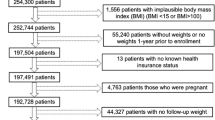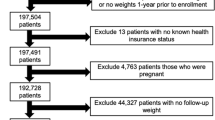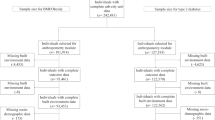Abstract
Background/Objectives
Neighborhoods are complex, multidimensional systems. However, the interrelation between multiple neighborhood dimensions is seldom considered in relation to youth adiposity. We created a neighborhood typology using a range of built environment features and examined its association with adiposity in youth.
Subjects/Methods
Analyses are based on data from the QUALITY cohort, an ongoing study on the natural history of obesity in Quebec youth with a history of parental obesity. Adiposity was measured at baseline (8–10 years) and follow up, ~8 years later. Neighborhood features were measured at baseline through in-person neighborhood assessments and geocoded administrative data and were summarized using principal components analysis. Neighborhood types were identified using cluster analysis. Associations between neighborhood types and adiposity were examined using multivariable linear regressions.
Results
Five distinct neighborhood types characterized by levels of walkability and traffic-related safety were identified. At ages 8–10 years, children in moderate walkability/low safety neighborhoods had higher BMI Z-scores [β: 0.41 (0.12; 0.71), p = 0.007], fat mass index [β: 1.22 (0.29; 2.16), p = 0.010], waist circumference [β: 4.92 (1.63; 8.21), p = 0.003], and central fat mass percentage [β: 1.60 (0.04; 3.16), p = 0.045] than those residing in moderate walkability/high safety neighborhoods. Attenuated associations were observed between neighborhood types and adiposity 8 years later. Specifically, residents of moderate walkability/low safety neighborhoods had a higher FMI [β: 1.42 (−0.07; 2.90), p = 0.062], and waist circumference [β: 5.04 (−0.26; 10.34), p = 0.062].
Conclusions
Neighborhoods characterized by lower traffic safety appear to be the most obesogenic to children, regardless of other walkability-related features. Policies targeting neighborhood walkability for children may need to prioritize vehicular traffic safety.
This is a preview of subscription content, access via your institution
Access options
Subscribe to this journal
Receive 12 print issues and online access
$259.00 per year
only $21.58 per issue
Buy this article
- Purchase on Springer Link
- Instant access to full article PDF
Prices may be subject to local taxes which are calculated during checkout

Similar content being viewed by others
References
van der Klaauw Agatha A, Farooqi IS. The hunger genes: pathways to obesity. Cell. 2015;161:119–32. https://doi.org/10.1016/j.cell.2015.03.008.
World Health Organization. Obesity and overweight: key facts. 2020. https://www.who.int/news-room/fact-sheets/detail/obesity-and-overweight.
Singh AS, Mulder C, Twisk JW, van Mechelen W, Chinapaw MJ. Tracking of childhood overweight into adulthood: a systematic review of the literature. Obes Rev. 2008;9:474–88. https://doi.org/10.1111/j.1467-789X.2008.00475.x.
Biro FM, Wien M. Childhood obesity and adult morbidities. Am J Clin Nutr. 2010;91:1499S–505S. https://doi.org/10.3945/ajcn.2010.28701B.
Sallis JF, Cervero RB, Ascher W, Henderson KA, Kraft MK, Kerr J. An ecological approach to creating active living communities. Annu Rev Public Health. 2006;27:297–322. https://doi.org/10.1146/annurev.publhealth.27.021405.102100.
Bleich SN, Segal J, Wu Y, Wilson R, Wang Y. Systematic review of community-based childhood obesity prevention studies. Pediatrics. 2013;132:e201–10. https://doi.org/10.1542/peds.2013-0886.
Zhang X, Onufrak S, Holt JB, Croft JB. A multilevel approach to estimating small area childhood obesity prevalence at the census block-group level. Prev Chronic Dis. 2013;10:E68. https://doi.org/10.5888/pcd10.120252.
Willms J, Tremblay M, Katzmarzyk P. Geographic and demographic variation in the prevalence of overweight Canadian children. Obes Res. 2003;11:668–73.
de Vet E, de Ridder DT, de Wit JB. Environmental correlates of physical activity and dietary behaviours among young people: a systematic review of reviews. Obes Rev. 2011;12:e130–42. https://doi.org/10.1111/j.1467-789X.2010.00784.x.
An R, Yang Y, Hoschke A, Xue H, Wang Y. Influence of neighbourhood safety on childhood obesity: a systematic review and meta-analysis of longitudinal studies. Obes Rev. 2017;18:1289–309. https://doi.org/10.1111/obr.12585.
Nordbo ECA, Nordh H, Raanaas RK, Aamodt G. Promoting activity participation and well-being among children and adolescents: a systematic review of neighborhood built-environment determinants. JBI Evid Synth. 2020;18:370–458. https://doi.org/10.11124/JBISRIR-D-19-00051.
Wang Z, Zhao L, Huang Q, Hong A, Yu C, Xiao Q, et al. Traffic-related environmental factors and childhood obesity: a systematic review and meta-analysis. Obes Rev. 2021;22:e12995. https://doi.org/10.1111/obr.12995.
Gauthier KI, Krajicek MJ. Obesogenic environment: a concept analysis and pediatric perspective. J Spec Pediatr Nurs. 2013;18:202–10. https://doi.org/10.1111/jspn.12027.
Mackenbach JD, Rutter H, Compernolle S, Glonti K, Oppert JM, Charreire H, et al. Obesogenic environments: a systematic review of the association between the physical environment and adult weight status, the SPOTLIGHT project. BMC Public Health. 2014;14:233. https://doi.org/10.1186/1471-2458-14-233.
Seliske L, Pickett W, Janssen I. Urban sprawl and its relationship with active transportation, physical activity and obesity in Canadian youth. Health Rep. 2012;23:17–25.
Fenton M. Community design and policies for free-range children: creating environments that support routine physical activity. Child Obes. 2012;8:44–51. https://doi.org/10.1089/chi.2011.0122.
Dunton GF, Kaplan J, Wolch J, Jerrett M, Reynolds KD. Physical environmental correlates of childhood obesity: a systematic review. Obes Rev. 2009;10:393–402. https://doi.org/10.1111/j.1467-789X.2009.00572.x.
Ding D, Gebel K. Built environment, physical activity, and obesity: what have we learned from reviewing the literature? Health Place. 2012;18:100–5. https://doi.org/10.1016/j.healthplace.2011.08.021.
Carter MA, Dubois L. Neighbourhoods and child adiposity: a critical appraisal of the literature. Health Place. 2010;16:616–28. https://doi.org/10.1016/j.healthplace.2009.12.012.
Ding D, Sallis JF, Kerr J, Lee S, Rosenberg DE. Neighborhood environment and physical activity among youth a review. Am J Prev Med. 2011;41:442–55. https://doi.org/10.1016/j.amepre.2011.06.036.
Leal C, Bean K, Thomas F, Chaix B. Multicollinearity in associations between multiple environmental features and body weight and abdominal fat: using matching techniques to assess whether the associations are separable. Am J Epidemiol. 2012;175:1152–62. https://doi.org/10.1093/aje/kwr434.
McCormack GR, Friedenreich C, Sandalack BA, Giles-Corti B, Doyle-Baker PK, Shiell A. The relationship between cluster-analysis derived walkability and local recreational and transportation walking among Canadian adults. Health Place. 2012;18:1079–87. https://doi.org/10.1016/j.healthplace.2012.04.014.
McDonald K, Hearst M, Farbakhsh K, Patnode C, Forsyth A, Sirard J, et al. Adolescent physical activity and the built environment: a latent class analysis approach. Health Place. 2012;18:191–8. https://doi.org/10.1016/j.healthplace.2011.09.004.
Timperio A, Crawford D, Ball K, Salmon J. Typologies of neighbourhood environments and children’s physical activity, sedentary time and television viewing. Health Place. 2017;43:121–7. https://doi.org/10.1016/j.healthplace.2016.10.004.
Hobbs M, Griffiths C, Green MA, Jordan H, Saunders J, McKenna J. Neighbourhood typologies and associations with body mass index and obesity: a cross-sectional study. Prev Med. 2018;111:351–7. https://doi.org/10.1016/j.ypmed.2017.11.024.
Poulsen MN, Glass TA, Pollak J, Bandeen-Roche K, Hirsch AG, Bailey-Davis L, et al. Associations of multidimensional socioeconomic and built environment factors with body mass index trajectories among youth in geographically heterogeneous communities. Prev Med Rep. 2019;15:100939. https://doi.org/10.1016/j.pmedr.2019.100939.
Lambert M, Van Hulst A, O’Loughlin J, Tremblay A, Barnett TA, Charron H, et al. Cohort profile: the Quebec adipose and lifestyle investigation in youth cohort. Int J Epidemiol. 2012;41:1533–44. https://doi.org/10.1093/ije/dyr111.
Kuczmarski RJ, Ogden CL, Grummer-Strawn LM, Flegal KM, Guo SS, Wei R, et al. CDC growth charts: United States. Adv Data. 2000;314:1–27.
VanItallie TB, Yang MU, Heymsfield SB, Funk RC, Boileau RA. Height-normalized indices of the body’s fat-free mass and fat mass: potentially useful indicators of nutritional status. Am J Clin Nutr. 1990;52:953–9.
Marshall WA, Tanner JM. Variations in the pattern of pubertal changes in boys. Arch Dis Child. 1970;45:13–23.
Marshall WA, Tanner JM. Variations in pattern of pubertal changes in girls. Arch Dis Child. 1969;44:291–303. https://doi.org/10.1136/adc.44.235.291.
Paquet C, Cargo M, Kestens Y, Daniel M. Reliability of an instrument for direct observation of urban neighbourhoods. Landsc Urban Plan. 2010;97:194–201. https://doi.org/10.1016/j.landurbplan.2010.06.001.
Landis JR, Koch GG. The measurement of observer agreement for categorical data. Biometrics. 1977;33:159–74.
CRCHUM. 2013. http://megaphone.crchum.qc.ca/geonetwork/srv/en/main.home.
Leslie E, Coffee N, Frank L, Owend N, Baumane A, Hugo G. Walkability of local communities: Using geographic information systems to objectively assess relevant environmental attributes. Health Place. 2007;13:111–22.
Ward JH. Hierarchical grouping to optimize an objective function. JAm Stat Assoc. 1963;58:236–44. https://doi.org/10.1080/01621459.1963.10500845.
Tan P, Steinbach M, Kumar V. Cluster analysis: basic concepts and algorithms. Introduction to data mining. Boston: Addison-Wesley; 2005.
Holifield R, Porter M, Walker G. Introduction spaces of environmental justice: frameworks for critical engagement. Antipode. 2009;41:591–612. https://doi.org/10.1111/j.1467-8330.2009.00690.x.
Pabayo R, Belsky J, Gauvin L, Curtis S. Do area characteristics predict change in moderate-to-vigorous physical activity from ages 11 to 15 years? Soc Sci Med. 2011;72:430–8. https://doi.org/10.1016/j.socscimed.2010.09.039.
Oluyomi AO, Lee C, Nehme E, Dowdy D, Ory MG, Hoelscher DM. Parental safety concerns and active school commute: correlates across multiple domains in the home-to-school journey. Int J Behav Nutr Phys Act. 2014;11:32. https://doi.org/10.1186/1479-5868-11-32.
Timperio A, Crawford D, Telford A, Salmon J. Perceptions about the local neighborhood and walking and cycling among children. Prev Med. 2004;38:39–47.
Timperio A, Salmon J, Telford A, Crawford D. Perceptions of local neighbourhood environments and their relationship to childhood overweight and obesity. Int J Obes. 2005;29:170–5. https://doi.org/10.1038/sj.ijo.0802865.
Timperio A, Reid J, Veitch J. Playability: built and social environment features that promote physical activity within children. Curr Obes Rep. 2015;4:460–76. https://doi.org/10.1007/s13679-015-0178-3.
Rothman L, Buliung R, Macarthur C, To T, Howard A. Walking and child pedestrian injury: a systematic review of built environment correlates of safe walking. Inj Prev. 2014;20:41–9. https://doi.org/10.1136/injuryprev-2012-040701.
Hume C, Timperio A, Salmon J, Carver A, Giles-Corti B, Crawford D. Walking and cycling to school. Predictors of increases among children and adolescents. Am J Prev Med. 2009;36:195–200.
Carver A, Timperio AF, Crawford DA. Neighborhood road environments and physical activity among youth: the CLAN study. J Urban Health. 2008;85:532–44. https://doi.org/10.1007/s11524-008-9284-9.
Ghenadenik AE, Kakinami L, Van Hulst A, Henderson M, Barnett TA. Neighbourhoods and obesity: a prospective study of characteristics of the built environment and their association with adiposity outcomes in children in Montreal, Canada. Prev Med. 2018;111:35–40. https://doi.org/10.1016/j.ypmed.2018.02.018.
Daniels KM, Le-Scherban F, Schinasi LH, Moore K, Auchincloss AH, Forrest CB, et al. Cross-sectional associations of built and social neighborhood environment variables with body mass index in a large sample of urban predominantly African American children. Child Obes. 2021;17:209–19. https://doi.org/10.1089/chi.2020.0155.
Rothman L, Hagel B, Howard A, Cloutier MS, Macpherson A, Aguirre AN, et al. Active school transportation and the built environment across Canadian cities: Findings from the child active transportation safety and the environment (CHASE) study. Prev Med. 2021;146:106470. https://doi.org/10.1016/j.ypmed.2021.106470.
Wang Z, Zhao L, Huang Q, Hong A, Yu C, Xiao Q, et al. Traffic-related environmental factors and childhood obesity: a systematic review and meta-analysis. Obes Rev. 2020. https://doi.org/10.1111/obr.12995.
van Hecke L, Ghekiere A, Veitch J, Van Dyck D, Van Cauwenberg J, Clarys P, et al. Public open space characteristics influencing adolescents’ use and physical activity: A systematic literature review of qualitative and quantitative studies. Health Place. 2018;51:158–73. https://doi.org/10.1016/j.healthplace.2018.03.008.
Harrison F, Jones AP, van Sluijs EM, Cassidy A, Bentham G, Griffin SJ. Environmental correlates of adiposity in 9-10 year old children: considering home and school neighbourhoods and routes to school. Soc Sci Med. 2011;72:1411–9. https://doi.org/10.1016/j.socscimed.2011.02.023.
Jennings A, Welch A, Jones AP, Harrison F, Bentham G, van Sluijs EM, et al. Local food outlets, weight status, and dietary intake: associations in children aged 9-10 years. Am J Prev Med. 2011;40:405–10. https://doi.org/10.1016/j.amepre.2010.12.014.
Prentice AM, Jebb SA. Beyond body mass index. Obes Rev. 2001;2:141–7.
Wall MM, Larson NI, Forsyth A, Van Riper DC, Graham DJ, Story MT, et al. Patterns of obesogenic neighborhood features and adolescent weight: a comparison of statistical approaches. Am J Prev Med. 2012;42:e65–75. https://doi.org/10.1016/j.amepre.2012.02.009.
Meyer KA, Boone-Heinonen J, Duffey KJ, Rodriguez DA, Kiefe CI, Lewis CE, et al. Combined measure of neighborhood food and physical activity environments and weight-related outcomes: the CARDIA study. Health Place. 2015;33:9–18. https://doi.org/10.1016/j.healthplace.2015.01.004.
Dunton GF, Liao Y, Almanza E, Jerrett M, Spruijt-Metz D, Pentz MA. Locations of joint physical activity in parent-child pairs based on accelerometer and GPS monitoring. Ann Behav Med. 2013;45:S162–72. https://doi.org/10.1007/s12160-012-9417-y.
Jones M, Pebley AR. Redefining neighborhoods using common destinations: social characteristics of activity spaces and home census tracts compared. Demography. 2014;51:727–52. https://doi.org/10.1007/s13524-014-0283-z.
Palmer JR, Espenshade TJ, Bartumeus F, Chung CY, Ozgencil NE, Li K. New approaches to human mobility: using mobile phones for demographic research. Demography. 2013;50:1105–28. https://doi.org/10.1007/s13524-012-0175-z.
Kwan M-P. The uncertain geographic context problem. Ann Assoc Am Geogr. 2012;102:958–68. https://doi.org/10.1080/00045608.2012.687349.
Author information
Authors and Affiliations
Contributions
TAB funded the QUALITY Neighborhood study, conceived of the study design, oversaw the data collection, literature search, analytic approach, interpretation of findings, and drafting of the manuscript. AG performed analyses and contributed to the writing of the manuscript. AVH helped with the conception of the design and specific study aims, oversaw data collection, guided analyses, and contributed to the interpretation of findings. GC contributed to analyses, wrote portions of the manuscript, and contributed to the interpretation of findings. YK provided spatial data and contributed to the interpretation of findings. BC contributed to the analytic approach and to the interpretation of findings. MSC contributed to the study design conception, data collection, and interpretation of findings. MH is PI of the QUALITY study and is responsible for all individual data; she also contributed to the interpretation of study findings. All authors read and approved the final manuscript.
Corresponding author
Ethics declarations
Competing interests
The authors declare no competing interests.
Additional information
Publisher’s note Springer Nature remains neutral with regard to jurisdictional claims in published maps and institutional affiliations.
Supplementary information
Rights and permissions
About this article
Cite this article
Barnett, T.A., Ghenadenik, A.E., Van Hulst, A. et al. Neighborhood built environment typologies and adiposity in children and adolescents. Int J Obes 46, 588–596 (2022). https://doi.org/10.1038/s41366-021-01010-1
Received:
Revised:
Accepted:
Published:
Issue Date:
DOI: https://doi.org/10.1038/s41366-021-01010-1
This article is cited by
-
Examining the effects of cumulative environmental stressors on Gulf Coast child and adolescent health
Population and Environment (2023)
-
Validation of desk-based audits using Google Street View® to monitor the obesogenic potential of neighbourhoods in a pediatric sample: a pilot study in the QUALITY cohort
International Journal of Health Geographics (2022)
-
Associations of neighborhood walkability with moderate to vigorous physical activity: an application of compositional data analysis comparing compositional and non-compositional approaches
International Journal of Behavioral Nutrition and Physical Activity (2022)



